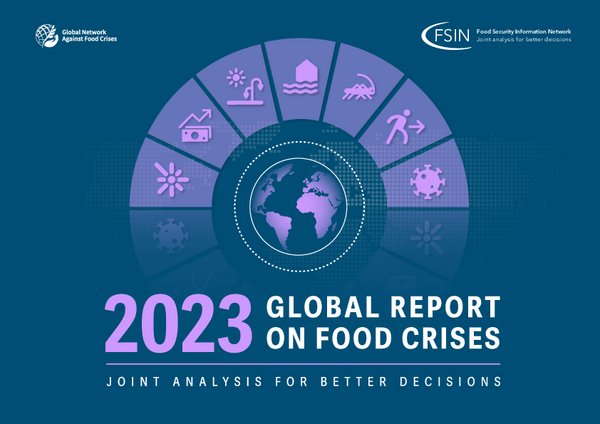 Read this article in French
Read this article in French- Share this article
- Subscribe to our newsletter
Global report on food crises
Around 258 million people in 58 countries and territories faced acute food insecurity at crisis or worse levels (IPC/CH Phase 3-5) in 2022, according to the latest edition of the Global Report on Food Crises (GRFC). The figure is up from 193 million people in 53 countries and territories in 2021, and it is the highest in the seven-year history of the report. However, much of this growth is due to an increase in the population analysed.
In 2022, the severity of acute food insecurity increased to 22.7 per cent, up from 21.3 per cent in 2021, reflecting a deteriorating trend in global acute food insecurity.
The annual report, produced by the Food Security Information Network (FSIN), was launched in May 2023 by the Global Network Against Food Crises (GNAFC). The GNAFC is an international alliance for tackling food crises, bringing together the UN, the EU, national government agencies and NGOs.
People in seven countries faced starvation
According to the report, more than 40 per cent of the population in IPC/CH Phase 3 or above lived in just five countries – Afghanistan, the Democratic Republic of the Congo, Ethiopia, Yemen and parts of Nigeria (21 states and the Federal Capital Territory or FCT).
People in seven countries faced starvation and destitution, or catastrophic levels of acute hunger (IPC/CH Phase 5) at some point during 2022. More than half of them were in Somalia (57 per cent), while these extreme conditions also occurred in Afghanistan, Burkina Faso, Haiti (for the first time in the history of the country), Nigeria, South Sudan and Yemen.
Around 35 million people experienced emergency levels of acute hunger (IPC/CH Phase 4) in 39 countries, with more than half of these located in just four countries – Afghanistan, the Democratic Republic of the Congo, Sudan and Yemen.
Additionally, in 30 of the 42 crisis contexts analysed in the report, over 35 million children under five years of age suffered from wasting or acute malnutrition. 9.2 million of these faced severe wasting, the most life-threatening form of undernutrition and a major contributor to increased child mortality.
Drivers of food insecurity: economic shocks, conflict and insecurity, and weather extremes
While conflicts and extreme weather events continue to drive acute food insecurity and malnutrition, the economic fallout of the СOVID-19 pandemic and the war in Ukraine have also become major drivers of hunger, particularly in the world’s poorest countries, mainly due to their high dependency on imports of food and agricultural inputs and their vulnerability to global food price shocks.
Economic shocks have surpassed conflict as the primary driver of acute food insecurity and malnutrition in several major food crises. Cumulative global economic disturbances, including soaring food prices and severe disruptions to markets, undermine countries’ capacity to respond to food shocks.
Worrying outlook for 2023
Conflicts, national and global economic shocks, and weather extremes are increasingly intertwined, creating spiralling effects for acute food insecurity and nutrition. And there is no indication that these drivers will ease in 2023: climate change is expected to drive further weather extremes, global and national economies face a grim outlook, and conflicts and insecurity are likely to persist.
For 38 of the 58 countries/territories, up to 153 million people (or 18 percent of the analysed population) will be in IPC/CH Phase 3 or above this year, according to projections from March 2023. In addition, around 310,000 people are projected to be in IPC/CH Phase 5 across six countries – Burkina Faso, Haiti, Mali, parts of Nigeria (26 states and the FCT), Somalia and South Sudan, with almost three quarters of them in Somalia.
(WFP/ile)





Add a comment
Be the First to Comment